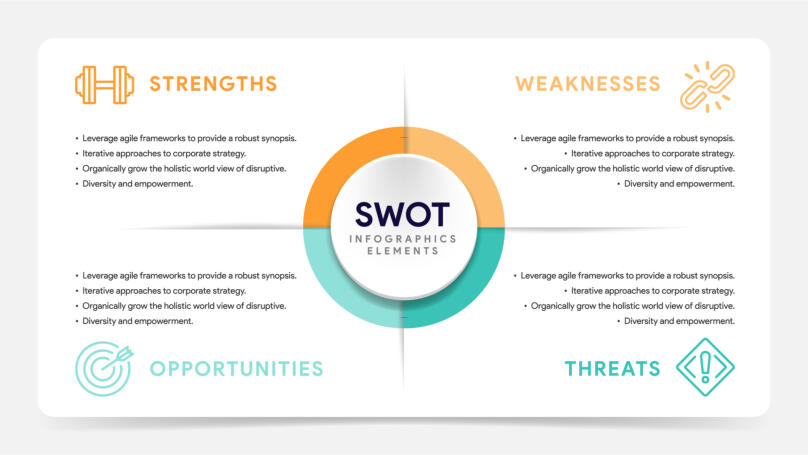SWOT Analysis
What is a SWOT analysis?

According to the generally accepted definition, SWOT analysis is a strategic management method that allows you to assess both internal advantages and disadvantages and external factors that can affect the life of a person or company.
Thanks to SWOT, you can identify problems and weaknesses in a timely manner, development of which will increase the efficiency of the enterprise and contribute to its growth.
To guarantee the accuracy of the analysis result, it is necessary to rely only on current, realistic and objective criteria. If possible, you should also contact an outside expert to ensure an unbiased view of the situation.
SWOT is also an acronym for Strengths, Weaknesses, Opportunities, and Threats.
SWOT analysis of a company
Since the main purpose of SWOT analysis is to understand how to do better and fix shortcomings, business is the most popular area for its application.
You can conduct an analysis both at the start of a business when planning a strategy, and during various projects to optimise workflows.
The goal of the SWOT analysis of a business is to increase the viability of the product in the market and boost the demand for it, thereby increasing the number of buyers and the company's profit. Typically, such an analysis is carried out regularly (once a quarter or every six months), using both standard programmes like Excel and PowerPoint, and special software designed specifically for SWOT and roadmaps.
Importance of SWOT analysis
Why do you need a SWOT analysis? First of all, it allows you to identify the areas in which you or your business are most effective, thanks to which you can turn these areas into your competitive advantage and create a separate niche for them.
Secondly, the advantages of SWOT analysis also lie in the fact that it allows you to:
-
get a detailed view of the state of your business to understand how to adjust current strategies, projects, or team actions;
-
gain a foothold in the market by strengthening the advantages and eliminating the disadvantages;
-
ensure business growth in the long term;
-
identify external and internal factors and their impact on the business, as well as learn how to use or terminate them.
However, we should also mention the weaknesses of SWOT analysis, which include:
-
The "here and now" results. This analysis reflects only the current situation without reference to the past and future, that is, without taking into account potential changes and turn-ups. Thus, if any factors or data change, you will have to conduct the SWOT analysis once again.
-
Lack of specifics. Of course, the analysis can be detailed by considering additional factors and issues, but, usually, it is still not enough for full-fledged planning.
-
The need for competent analysts and reliable data. With any subjective distortion, the effectiveness of the SWOT analysis is reduced. That is why a very responsible and professional approach to working with it is required. Therefore, the analysis is typically conducted by a specialist hired specifically for this purpose.
Strengths in SWOT analysis

SWOT analysis is practised by both small businesses and large companies like Amazon, Starbucks, Nike, Mcdonald's, Coca-Cola, Netflix, Tesla, and Nestle. To study its structure, let's take Apple's report for 2022, which is available in the public domain on the company's official website, as an example of SWOT analysis.
What is Strengths in SWOT analysis
The list of strengths is a description of how the company differs from competitors, what makes it unique, and what it is really good at. This may be related to the brand and reputation, to the customer base, the product itself, or the technology used. Knowing its strengths, the company knows what is important for its customers and what needs to be emphasised in its positioning.
Examples of strengths in SWOT analysis
In Apple's case, these are:
- The highest brand value. In 2022, Interbrand once again ranked Apple 1st, recognising it as the richest company with a value of $408 billion. By the way, after Apple comes Amazon with a value of $249 billion, and then Microsoft with a value of $210 billion.
- Worldwide reputation. Apple occupies the first places in all popularity ratings, as more than 2 billion people actively use its products, with even more people knowing about it. Moreover, it is Apple products that are most often used in offices and by professionals in different market segments, since Mac Pro or iMac offer the most high-performance technologies for programming, design, and video production.
- State-of-the-art technology. Apple is a pioneering company that sets trends in the market. It was the first company to show the world how convenient and user-friendly a smartphone, headphones, or music player can be.
Weaknesses in SWOT analysis
What is weakness in SWOT analysis
Weaknesses are what hinders the development of an organisation and interferes with its victory over competitors. Essentially, these are areas that need optimisation and improvement, which overburden the business and create obstacles for promotion.
As is the case with advantages, weaknesses can be associated with the brand (if, for example, it is not developed enough), inefficient marketing, supply, lack of capital, the company's employees, etc.
Examples of weakness in SWOT analysis
Despite all its strengths, Apple also has weaknesses, namely:
- High price.
In most countries, Apple products are classified as premium, available only to buyers with an upper average income. Low-income consumers either apply for a loan or choose competing manufacturers with better value for money. - Limited "universe".
Apple products cannot be combined with other brands' products or software. When purchasing Apple products, the user finds themselves in a "closed space" with a limited set of applications and features that they cannot expand on their own, as is possible with Android-based products. - Lack of competence in the areas of intersection.
To remain competitively viable, Apple is rapidly introducing new services similar to Netflix (Apple TV), PayPal (Apple Pay), and others. Nevertheless, these services are not the main focus of the company, which is why it allows flaws in them and does not pay enough attention to their development and funding.
Opportunities in SWOT analysis
What is opportunities in SWOT analysis
Opportunities are those favourable factors and opportunities that the company can use and add to the list of its strengths. For example, if the import tax in a country is reduced, then the company can introduce its products to a new national market.
Examples of opportunities in SWOT analysis
In Apple's case, we can highlight:
- Continuous growth of the customer base.
Due to the dominance in the technology sector, the number of people who buy Apple technology is constantly increasing with each year. After all, it is the development and release of new technologies that is the basis for "fresh" versions of its products. So, Apple's customer retention rate is 92%, which is a worldwide record. - No green technologies.
Apple is currently absent from the niche of environmentally friendly and safe products, which is a potential field for expanding the classic product line. - Extensive distribution network.
Apple already has a network of distributors that plays a passive role in the company and has its limitations. However, if Apple weren't so tough on potential partners and provided them with new opportunities for growth, it could generate new revenue sources for the company.
Threats in SWOT analysis
What is threats in SWOT analysis
Threats are external factors that, under adverse circumstances, can pose a threat to the company's well-being and harm its reputation, value, performance, and sales. For example, an unexpected rise in material prices due to the economic crisis can severely impact a company's pricing and resources.
Examples of threats in SWOT analysis
In Apple's case, we can detect the following threats:
- Impact of the coronavirus pandemic.
China is Apple's key manufacturing and supply partner, accounting for more than 18% of its revenue (approximately $365 billion). Due to the quarantine imposed in China, Apple's work was partially paralysed, as was the work of local factories, which greatly affected Apple's performance compared to previous years. Moreover, according to experts, this will influence the company for several more years. - China's high rates.
The second threat is also associated with China. More specifically, with the tariff imposed by the US government on the import of Chinese products, which increased its value as a result. Consequently, the company's gross profit has decreased because now even fewer people can afford its products. - Competing with fakes.
Of course, it is not like there is a real competition, but nevertheless, Apple products are more vulnerable than ever to brand image abuse. In the markets of Third World countries and even in some European ones, you can find counterfeit products that undermine the company's reputation.
How to do a SWOT analysis

You can complete a SWOT analysis in just a few steps.
Step 1. Coming up with questions and answering them.
The success of a SWOT analysis largely depends on the questions that it will consist of. Depending on the level of detail that you need, and on the specifics of the business, the list of questions can be updated, but the main ones are as follows:
а) Strengths:
- What is your competitive advantage?
- What resources do you have?
- What are your employees' strengths?
- Why do customers choose you?
b) Weaknesses:
- What do you lack qualifications or experience in?
- In what ways are your competitors better than you?
- What do your customers complain about the most?
- What weaknesses do you see in your employees?
- What obstacles do you face most often?
- What resources are lacking?
- What can be improved?
c) Opportunities:
- To what extent are current market trends likely to benefit you?
- What are the positive aspects of the current economic situation?
- What new features are there that you haven't considered yet?
- Where can you get additional resources, and how?
d) Threats:
- Is the market volume shrinking?
- How can the current economic situation or market trends affect your business negatively?
- Is the price of your goods increasing? How does this affect your customers?
- How reliable are your partners and resources?
Step 2. Writing down the answers and reviewing the results
The answers are processed either through brainstorming sessions involving the entire office or by trained staff with professional analytical skills. It is also desirable to visualise your results (see below for how to do that).
Step 3. Developing strategies
After you receive all the answers and data, you need to use it to come up with a set of solutions to develop all strengths and eliminate weaknesses, including threats.
The result summed up in the course of the SWOT analysis will also set the vector for the company's further development and suggest what steps you need to take to improve the performance or the situation as a whole.
Personal SWOT analysis
Despite the fact that SWOT analysis is most often used to analyse businesses, it can also be used to analyse a person.
Specifically, personal SWOT analysis helps to identify your strengths and weaknesses so that you can eliminate potential threats by yourself and move freely towards your goal.
There is also a kind of SWOT analysis of a student, which helps to identify hidden talents and abilities in children and teens, which can be developed and turned into their profession in the future. In the same way, you can carry out SWOT analysis of self to check the accuracy of self-perception.
Personal SWOT analysis examples
This is how an example of analysing personal strengths in a SWOT analysis looks like:
"I am a goal-oriented sales manager who easily finds an approach to a person. I am not afraid to be rejected, so I boldly approach people and offer them help. I quickly remember new information and close most of the deals."
You can identify the following personal strengths from this statement:
-
Sociability
-
Self-discipline
-
Courage
-
Rich experience
The analysis of weaknesses would look like this:
"Sometimes I snap at rude customers, so I should work on self-control. I also have trouble concentrating when I need to complete paperwork or write a report. My boss says I'm too careless."
This explains that
-
The person needs to upgrade technical skills such as bookkeeping and maintaining paperwork to make these duties easier;
-
They should continue to work on their emotional intelligence, but in terms of self-control;
-
Perhaps carelessness stems from fatigue or an inability to analyse the situation at hand.
SWOT analysis templates
There are many ways to fill out a SWOT analysis, but people most often use a matrix or square-like table divided into four fields, each of which contains one SWOT element.
Such visualisation makes it easier to assess the position of the company and allows you to see the whole picture, as well as draw parallels and build logical chains.
All items included in the field may have varying degrees of importance and priority, but they all should reflect some idea and have an impact on the success of the company or individual.
Here is a ready-made classic template, which can be used for both students and businesses:
























